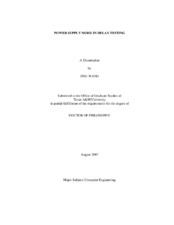| dc.description.abstract | As technology scales into the Deep Sub-Micron (DSM) regime, circuit designs have
become more and more sensitive to power supply noise. Excessive noise can significantly
affect the timing performance of DSM designs and cause non-trivial additional delay. In
delay test generation, test compaction and test fill techniques can produce excessive power
supply noise. This will eventually result in delay test overkill.
To reduce this overkill, we propose a low-cost pattern-dependent approach to analyze
noise-induced delay variation for each delay test pattern applied to the design. Two noise
models have been proposed to address array bond and wire bond power supply networks,
and they are experimentally validated and compared. Delay model is then applied to
calculate path delay under noise. This analysis approach can be integrated into static test
compaction or test fill tools to control supply noise level of delay tests. We also propose
an algorithm to predict transition count of a circuit, which can be applied to control
switching activity during dynamic compaction.
Experiments have been performed on ISCAS89 benchmark circuits. Results show that
compacted delay test patterns generated by our compaction tool can meet a moderate
noise or delay constraint with only a small increase in compacted test set size. Take the benchmark circuit s38417 for example: a 10% delay increase constraint only results in
1.6% increase in compacted test set size in our experiments. In addition, different test fill
techniques have a significant impact on path delay. In our work, a test fill tool with supply
noise analysis has been developed to compare several test fill techniques, and results show
that the test fill strategy significant affect switching activity, power supply noise and
delay. For instance, patterns with minimum transition fill produce less noise-induced
delay than random fill. Silicon results also show that test patterns filled in different ways
can cause as much as 14% delay variation on target paths. In conclusion, we must take
noise into consideration when delay test patterns are generated. | en |


